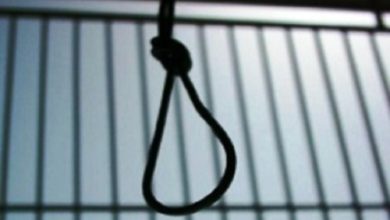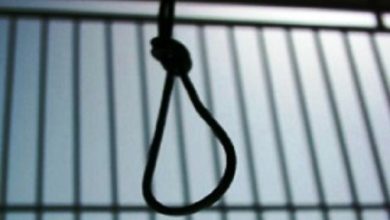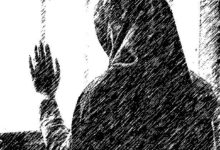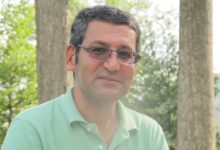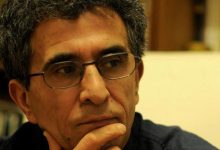Witness Statement of Abdullah Mostafa Soltani
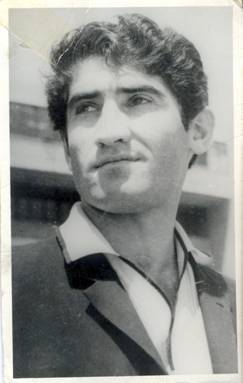 A young Foad Mostafa Soltani, brother of the witness and one of the leaders of the Komala. |
|---|
Name: Abdullah Mostafa Soltani
Place of Birth: Mariwan, Iran
Interviewing Organization: Iran Human Rights Documentation Center (IHRDC)
Date of Interview: February 20, 2011
Interviewer: IHRDC Staff
Witnesses:NONE
This statement was prepared pursuant to an in person interview with Abdullah Mostafa Soltani. The statement was approved by Abdullah Mostafa Soltani on September 23, 2011. There are 65 paragraphs in the statement.
The views and opinions of the witness expressed herein do not necessarily reflect those of the Iran Human Rights Documentation Center.
Statement
1. I am Abdullah Mostafa Soltani. I was born in the city of Mariwan. After the IRI took power, I participated in the Kurdish resistance against the Islamic dictatorship in Kurdistan because I opposed their violent stances against the Kurdish nation.
2. I was a member of Komala—or the Organization of Revolutionary Toilers of Iranian Kurdistan. From the onset of the attack on Kurdistan and Khomeini’s verdict of Jihad, I, along with the Kurdish opposition forces, fought the IRI forces.
3. When the IRI came to power, in the summer of 1979, nine people were executed in the city of Mariwan. Two of them were my brothers Hossein and Amin. They were executed on August 25, 1979.
4. Six days later, my brother Kak Foad, a political activist and one of the founders of Komala, traveled from Baneh to Mariwan to visit our family and participate in my brothers’ funeral. En route he got caught in battle with IRI forces and was martyred at war.
5. In 1981 two of my other brothers, Majed and Amjad, were arrested after the bombing in the Islamic Republic Party Headquarters that killed around 70 people. After that bombing the government began mass executions in Iranian prisons. They killed my brothers in Tabriz prison.
6. Also, during the resistance of Kurdistan, our groom and my sister Malakeh’s husband, Ja’far Shafi’i was killed. Two of my paternal uncle’s sons, Naser and Ahmad, were killed as well. The rest of my brothers are still alive.
7. I fought until I was injured in 1989, then I came to Germany for recuperation and stayed here.
Early Years in Mariwan
8. In Iran, I lived in the city of Mariwan. I was born into a large family. My father had two wives with whom he had twelve sons and three daughters.
9. By order of birth, my siblings are Saeed (1940), Mohammad (1942), Taher (1947), Kak Foad (1948), Rashad (1948), Hossein (1950), Faezeh (1952), Amin (1953), Abdullah—myself (1953), Majed (1955), Najiyeh (1957), Malakeh (1957), Amjad (1958), Reza (1960), and Heshmat (1961).
10. My father was a religious and educated man. He finished school under Reza Shah’s rule and was a teacher for a short period of time. Although we lived in a village he insisted on all of us getting a secondary education. Despite the educational limitations of the time, after we finished our primary education, my father took the risk of sending us from our little village to Sanandaj to continue our secondary education.
11. The people of Iran achieved a lot during the Pahlavi era. The problem was primarily that the political atmosphere was suffocating: people didn’t have the right to participate in partisan, civil, and democratic activities. Iran’s people rose up to gain more than what the Shah’s regime offered them. Ironically, when the Shah’s regime was toppled and political Islam and Khomeini gained control, people became even more restricted
12. My brother Kak Foad Mostafa Soltani[1] was one of the founders of Komala. He was imprisoned for a long time with Misters Montazeri, Rafsanjani, and Taleghani and understood from then on what Islamic philosophical ideology was comprised of.
13. One of the theoreticians of Velayat-e Faqih was Mr. Montazeri, who explained the concept clearly to my brother in prison. He told my brother they would institute Velayat-e Faqih if and when they gained power—it was clear to us that Velayat-e Faqih was a dark religious dictatorship, much worse than a monarchy. Therefore, from day one Komala’s stance was to say no to a political Islam that wanted to gain power. We followed Komala’s advice and opposed the political Islam that Khomeini wanted to institute in Iran.
Post-Revolution Mariwan
14. Given my stance on political Islam, I didn’t vote in the Referendum although I was of voting age. In its wording, the referendum was greatly limiting. It asked: “Islamic Republic, yes or no?” This was undemocratic for us because there were a great number of people in Iran who were not believers in Islam. Some adhered to other faiths, while others were atheists. Yet this ballot restricted them to a choice of an Islamic Republic and provided no other alternative.
15. I was in Mariwan at the time of the Iranian government’s attack. From the onset of the Kurdish people’s resistance against the Islamic Republic I was present both as a witness and a player in the movement.
16. My family and I were involved in the Kurdish national resistance because Kak Foad was a founder of Komala and we were politically active. Komala played a key role in organizing the masses and enabling people to fight against the monarchy. After the overthrow of the monarchy, Komala played a role in developing Kurdish national demands from the new government. Komala had influence and a base among the masses. It was founded in 1968 and acted in secret. Many of its founders and its cadres were imprisoned during monarchical rule—like Kak Foad, who was released in the fall of 1978.
17. On February 11, 1979, the Islamic Republic came to power. From the first days of the Islamic Republic coming to power, we expressed the Kurdish nation’s demands to people such as Mr. Dariush Forouhar, who came to Kurdistan and was later killed by the Islamic Republic. Committees were sent and we handed over our demands. Our minimum request was that law enforcement in Kurdistan be left to the Kurdish people and for the military to not interfere in people’s affairs and lives. We also requested that cities and villages be run by elected councils and demanded to use Kurdish languages. Komala argued with the Islamic Republic over these demands but the IRI paid no mind to this request and intended to fight the Kurds.
18. On or before Nowruz, in March of 1979, the city of Sanandaj was attacked. The army was commanded to shower the city with mortars. Fighter planes flew over the city and dumped bombs and rockets on the people of Sanandaj. Five thousand people were killed. The government used any excuse to attack Kurdistan and kill innocent people and civilians. The newspapers and speeches of the time document the government’s desire to crush the Kurds.
Incident of 23 Tir 1358 (July 14, 1979)
19. In the city of Mariwan there were demonstrations against the poisonous broadcasts of the radio and television and Mr. Ghotbzadeh, a prominent figure in the Islamic Republic who was later executed by the government, who at the time was head of radio and television. He spread negative propaganda on television and radio about the resistance movement of the Kurdish nation. In response, we staged a protest in front of the radio and television building of Mariwan and demanded an end to the negative propaganda.
20. There was a base in front of the radio and television building that belonged to the Revolutionary Guards and armed natives of Maktab-e Koran of Mariwan—Mr. Moftizadeh’s clan. These people shot and killed three people from the rooftop and twelve people were injured. The three people killed included a member of Komala named Rauf Kohnehpooshi; a farmer from Balak village near Mariwan named Mahmoud Balaki; and an employee of the Mariwan municipal office named Mohammad Darseem.
21. This event happened on July 14, 1979, and came to be known as the incident of 23 Tir 1358 [the date in the Persian calendar].
Failed Negotiations and Exodus from Mariwan
22. After the Bloody Nowruz of Sanandaj, a delegation including Taleghani, Beheshti and Rafsanjani, and Bani-Sadr, Ghotbzadeh and Sahabi came to Sanandaj. There was an agreement that Kurdistan’s governance would be in the hands of Councils elected by the people. As a start, the first one of such councils was formed in Sanandaj and was to be extended to the rest of Kurdistan. In almost all Kurdish cities provisional councils were formed and the governance was under the supervision of the councils. The government was to provide this for the Kurds. But they set up bases for the Revolutionary Guards all over Kurdistan.
23. People got angry and single handedly took over the base of the Revolutionary Guards. Nine Sepah were killed. The Islamic Republic used this as an excuse to attack Kurdistan. City council members implored central government authorities that what happened shouldn’t have happened and said to make it right, a case file should be formed and sent to court for a fair trial.
24. The Supreme Court gave permission to an employee of the Office of Justice of Mariwan to research the matter. It turned out that there were cards in the pockets of those who were in the Revolutionary Guards’ base and in hospital belonging to an “assassination and explosion” group. This was unexpected: why would the Revolutionary Guards’ base need to have an explosion and assassination group? Who were they going to assassinate? Was it part of a conspiracy? Later it was discovered that the individuals killed in random shootings around the city during nighttime were killed by those people. At the same time Ayandegan newspaper published a story about these occurrences. Their identity cards were also printed and disseminated across Iran.
25. After several days of talks with Mr. Chamran, in the end Mr. Chamran said to the City Council: “We have come to combat, not to establish order.” Then, Kak Foad said, “Fine! If this is so and you have come to attack us, we will leave the city. You can attack an empty building. Why should innocent women and children be killed?”
26. The people of Mariwan migrated to the border of Iraq and set up camp there. In support of the migration, the people of Sanandaj, Baneh, and Bukan walked to Mariwan to support the people. The result of this mass migration was that the Army controlled the law enforcement of the city until the city council could reorganize the police force. Also, according to an agreement, the Revolutionary Guards’ base had to be removed and a delegation needed to investigate the incident to see who was at fault.
27. On August 13 people started their return to the city. The army took up the law enforcement of the city according to the agreement—it guarded the city gate and arrested every person who was suspicious to them, including two of my brothers, Amin and Hossein. They were arrested on the eve of August 17-18 and executed without any trial.
Khomeini’s Fatwa and Attack on Iran’s Kurdish Region
28. On August 19, 1979, after the conflict in the town of Paveh, Khomeini issued the order of Jihad. Although we left Mariwan and tried our best to neutralize the desire of the Islamic Republic to attack Kurdistan, Paveh gave them the opportunity they wanted.
29. Khomeini announced that news had reached him that in Kurdistan, women and children were kept captive in the mosque. Although people sent him telegrams telling him that the news was not true, he ordered Jihad anyway. The army attacked and made life hell for the people of Kurdistan. My friend from Isfahan told me that 165,000 people in Isfahan signed up in mosques to participate in the attack on Kurdistan.
30. There are certain pillars in the Muslim faith and one of them is Jihad. The order of Jihad is usually given against infidels who have attacked Muslims. Khomeini did not issue a Fatwa for Jihad against the monarchist government. Nor did he issue one during the eight long years his regime fought Saddam’s Ba’athist regime. But he issued a Fatwa for Jihad against his own Kurdish, Muslim countrymen. He paved the way for reactionary and ignorant Revolutionary Guards to massacre and kill at will.
31. The people had no security against Pasdars who attacked Kurdistan. For them it was quite simple: we were infidels and should be killed. They had a justification for it too! If you killed an infidel you would go to heaven. If he was innocent then after dying he would go to heaven—thus perversely the killer would then be responsible for an innocent man going to heaven. For that very reason, on judgment day the killer got bonus points because he helped bring an innocent man to heaven. This was Khomeini’s theory of Shi’a Islam.
32. The demands of the Kurdish Nation were first presented in an eight-point order, which later became a ten-point order. The IRI was dismissive of the demands—they said: we still haven’t settled in properly but after we take control of the country, we’ll process your demands. The August 19, 1979 attack on Kurdistan left no option but to defend against the armed assailants.
33. At the time of the government’s attack I was 24 years old. I was a middle school teacher. After the attack on Kurdistan I became a peshmerga in the mountains.
34. Khomeini ordered a ceasefire in November and the armed forces returned. A series of negotiations began. Again Misters Forouhar and Sabbaghian and Ayatollah Eshraghi were sent to engage in discussion with the Kurdish opposition forces resisting the assault. At this time the Kurdish Democratic Party and Komala and the Office of Mamosta Sheikh Ezzedin Husseini and the Fedaian-e Khalq created the Delegation of Representatives of the Kurdish People (DRKP). The Delegation, in which Mamosta was the secretary, turned the demands of the Kurdish people into a 26-point resolution (otherwise known as the 24-point resolution) and presented it to the government. This resolution came to be known as the resolution for autonomy (and is available in the archives of various parties). The secretary of the Delegation was Sheikh Ezzedin Hosseini. The representatives from the Kurdistan Democratic Party were Abdulrahman Ghassemlou and Ghani Bolourian, the representatives from Komala were Abdollah Mohtadi and Dr. Ja’far Shafi’i (my sister Malakeh’s husband), and there were representatives from the Fedaian as well.
35. It was clear from the start that the government did not harbor good intentions towards the Kurdish nation. From the beginning, they said in their speeches that autonomy was the same as separatism and secession. They feared that Kurds wanted to separate. The Kurdish people said time and time again that they did not want separation and merely wanted to have a hand in their own fate. But no one listened. Of course, this doesn’t mean that the Kurdish nation was willing to endure any humiliation and still not separate. But autonomy was in the Kurdish people’s best interests.
36. When Siyah Jamegan[2] entered the city, Komala fighters left the city. Fighting with Chamran began in Paveh. The headquarters in Sanandaj told us to empty the Mariwan office. We had offices for various divisions within Komala such as a peasants’ union and an unemployed workers’ union and a society of teachers—in which my brothers were members.
37. They packed up the office and were set to leave the city when they were arrested. They were in the car along with Hossein and Ahmad Pirkhezri and a doctor by the name of Bahman Akhzary who came to help the people during the migration. Their entire car was arrested.
38. On the day of their arrest they were trying to leave the city but I was going to remain behind so I could get news. But news came that they were arrested. I hid in a house in town and at night left for Almaneh.
39. Aside from them Jalal Nasimi, Faegh Azizi, and two others were among those executed. They say that members of the Maktab-e Koran of Ahmad Moftizadeh identified and arrested the car that my brothers were in. The Maktab-e Koran clan aided the Islamic Republic a lot. When they started the arrests it became clear that the Islamic Republic turned its back on all their agreements and didn’t follow through with any of the promises made. We were faced with a fanatic bunch that pledged to Khomeini and followed his lead. All of Kurdistan was in fear and shock. Because this had never happened before. Many Pasdars were under the influence of their respective sources of emulations and were misinformed and did not know that they are combating ordinary people of Kurdistan. But these groups called the Kurds sinners and fighters [against the regime].
40. When we captured them in battle and treated them like human beings they were surprised. We gave blood to the injured and dressed the wounds. Then we handed them to the people to deliver them to their families or military bases.
41. Mr. Moftizadeh was later arrested and imprisoned. He was exposed for what he truly was and spent the rest of his days in his home in Kermanshah under house arrest. A chasm was created in the Maktab-e Koran as well. A group of them have become radical extremists like al-Qaeda. Another group is like the Ansar-e Hizbullah[3] and another one is Islamic. The Maktab-e Koran was suspected to have aided SAVAK as well. They were concerned about leftist guerrilla activities in Iran and feared the Communists. They knew that Komala was a leftist group but they did not know it was so well organized. The IRI gave them a lot of leeway because they were Muslim. And they thought that the IRI would eventually institute an Islamic government; and hence they would benefit. Therefore they did not mesh with the Kurdish movement. In the first waves of assault of the IRI to Kurdistan the Maktab-e Koran helped them a lot.
42. None of the promises given on July 16 were fulfilled. Khomeini even ordered Jihad on Kurdistan. There were no trials.
43. On July 18 when Amin and Hossein were arrested, the first thing we did was tell my father. He went to the military base in Mariwan and met with Khalkhali. Khalkhali threatened my father—he said his sons are infidels and did not know the Quran. My father said after 50 years of monarchical rule the kids at school did not learn the Quran and prayers and that the new regime must give them time to learn. My father could argue with Khalkhali because he was a learned man who knew the Quran. Khalkhali was stuck—he finally told my father to bring the deed to his house the next day at 5 P.M. in exchange for his sons’ release.
44. Jalal Nasimi and Ahmed Pirkhezri were also released but lured back to the office. They were told they needed to sign a form but then they were executed.
45. My father returned the next day with the necessary documents but instead of his sons’ release, he was handed their dead bodies. He found Khalkhali and fought with him, he said: I brought the deed but you handed me corpses? Khalkhali said, well this is Islam, the verdict of the Quran. If your kids were guilty then they will go to hell and if they were innocent they will go to heaven. Incidentally, it was the month of Ramadan.
46. I went into hiding the day my brothers were executed. The corpses of Amin and Hussein were dumped in front of Mariwan hospital. Blood still dripped from them and the bodies were still warm. People gathered around and some took my dead brother Hussein to the mosque and shrouded him and prepared him for a funeral.
47. Amin was brought with the same blood-soaked clothes to my hometown of Almaneh on August 25, 1979. My mother looked for the corpse of Hussein in the mosque. The bodies were brought for burial and traditional Kurdish ceremonies performed. I was there when people brought their bodies to the village.
48. The nine people killed that day included my brothers Hossein and Amin, brothers Ahmed and Hossein Pirkhezri who were the only sons of their family, Jalal Nasimi, a member of the City Council named Faegh Azizi, and Mahmoud, who was a peshmerga for the Patriotic Union of Kurdistan and had come to see his relatives in Mariwan. With no trial or evidence against him, he was executed. Members of the Maktab-e Koran identified him. There was also Bahman Akhzary.
Death of Brother Foad
49. Kak Foad was martyred six days after the execution of Amin and Hussein in a conflict with the IRI. His body was left on the side of the road. A villager saw the body and recognized him and remained with the body until morning. The news reached town that Kak Foad’s body was at that location. Cars transported the body to Mariwan and then to the village of Almaneh.
50. When this happened, it was only the sixth day of mourning for our other two brothers. I was sort of hiding at the time yet I was on the watch to warn everyone else if pasdars came. I saw a convoy of cars bring the body. We buried it.
Executions of Majed and Amjad
51. My brother Majed studied electrical engineering and went back to medical school. He was in his last year when the uprising happened. The killing of Kak Foad affected him a lot. He came back to work in Komala and was in charge of the Tabriz branch because he went to school there and knew the town. On a reconnaissance mission, he was exposed and arrested. At the time of his arrest, he had a fake birth certificate with the name Sadegh Khodadoust in his pocket. He was taken to prison and tried and interrogated with the fake name. However, his cover was later blown by members of the Fedaian Majority or the Tudeh party.
52. Amjad was a student in Urban Planning in Reza’iyeh University. Our sister Faezeh was staying with him and was sick so they went to Tabriz so that Faezeh could visit a doctor. There they crossed paths with a Komala member who insisted that they stay with him and not in a hotel. Unfortunately however his house had been identified by the IRI. The house was searched, Komala documents were seized, and they were arrested and imprisoned. Upon arrest they were identified to be Mostafa Soltanis because they had documents of identification on them. Apparently, by that time Majed had been identified as well.
53. After the bombing at the Islamic Republic Party headquarters, the two of them were charged with being the brothers of Kak Foad and executed. There was no other evidence against them. Majed’s interrogator in Tabriz was Saeed Mortazavi.[4] Majed sent a letter from prison saying that Judge Mortazavi and someone else tried him and that he defended himself but he was told that his crime was that he was the brother of Kak Foad. Majed’s “trial” was on August 22, 1981 and Amjad and Majed were both executed the same day. Interestingly when they were taken for execution, they saw each other for the first time. Until then Majed didn’t know that Amjad was arrested.
54. I was a peshmerga at the time that the news of Majed’s arrest under the alias of Sadegh Khodadoust came. Komala even negotiated with government representatives for his release; in the past we conducted prisoner exchanges a few times. We had arrested Revolutionary Guards and Majed was supposed to be released in exchange for them but under the alias of Sadegh Khodadoust. Unfortunately, his real identity was uncovered.
55. My mother didn’t know anything about Majed being arrested. He was on the exchange list[5] and the exchange officer in Bukan took my hand and promised and swore to me that when he went in to hand the list of individuals to be exchanged, he would have Mr. Sadegh Khodadoust transferred that day with a helicopter from Tabriz to Saqqez so that he could be exchanged the following Tuesday. I told Dr. Ja’far, the exchange agent from Komala, what the officer had said about releasing Sadegh Khodadoust. I was concerned.
56. I was really worried and wondering why the exchange officer was talking to me. Maybe he had guessed that I am Majed’s brother although we had introduced him as Sadegh Khodadoust. Interestingly, the guy on the government’s side was the deputy prime minister or some other similar rank, and was a classmate of Dr. Ja’far in Tabriz University. They knew each other personally and when we met, Dr. Ja’far introduced as Foad’s brother. He left.
57. The next day the explosion of Islamic Republic Party took place.[6] Majed was taken back to Tabriz and executed. Amjad was executed with him. Without a trial or any other formality.
58. We knew Amjad had been arrested. My mother found out later. When he was killed my mother went to Tabriz to retrieve the body. She visited Mousavi Ardebili, Khomeini’s representative in Tabriz. He told my mother that she had to pay 5,000 tomans for each of the bodies that was the cost of the bullets each were shot with and take two bags of cookies for the team that executed them and then she can take the bodies and have a funeral. My mother did this and she was given a letter and she went to a cemetery where she saw piles of soil there and someone there said they are buried there. My mother turned over the earth with her bare hands. Amjad was in the first grave and she finally found Majed. The corpses were buried in shallow graves. She put the bodies in a car and brought them to Sanandaj to my brother Mohammad’s house. Sanandaj people gathered round the house and chanted slogans against the Islamic Republic. They arrested Mohammed and beat him but released him the next day and allowed him to take the bodies to Almaneh. Word spread in the region that their bodies had been taken to Almaneh. None of us were with my mother at the time. The only person staying with her was Faezeh and at that time she was in prison.
59. Dr. Ja’far and I were in the exchange committee from Komala side and someone was sent from the prime minister’s office and we’d participate in negotiations. I participated in negotiations that led to the exchange of three groups of prisoners. We’d give them the list and they would bring the prisoners and we would then sign the list and hand over the new list so they could go and prepare the prisoners. We’d tell them which prisoners to bring. In turn we’d hand over pasdars and soldiers who were taken hostage by us. In one exchange we handed over Mr. Habibian (I think his name was) who was the son in law of Mr. Montazeri. He was an important person and we had five people on death row released in exchanged for him. Once we handed over 42 soldiers in exchange for three followers of Komala. The soldiers had been taken hostage in combat. Our negotiations to release Majed referred to him with the name Sadegh Khodadoust because we thought he was not identified, which he was. Either way they brought him to Saqqez prison from Tabriz so as to exchange him but then return him to Tabriz.
60. They came to negotiate with us and we wouldn’t go. They sent an undercover agent to the city of Bukan. The city was in the control of the peshmerga. Because our negotiation partner was a former classmate and university buddy of Dr. Jafar he trusted us and came in the city and we handed him back by taking him near the entrance of Saqqez. The exchange took place in the location close to a base of the IRI in the mountains. It was on the road and the armed peshmerga would stand guard across the way. The peshmerga would take over the mountainous areas to prevent the IRI from cheating us. We would take our prisoners and they would bring theirs and then read the names from a list one by one and we would accept those released. They brought a list naming everyone who was their captive and we’d give them a list of people taken hostage by us so that they could tell us the individuals they wanted. They would announce the names of their captives on the radio too. When we took our prisoners someone from the other side had to come to ensure we don’t hand over the wrong person and vice versa we would take people who knew our people who were being released. We kept our prisoners in prison and would then take them to the exchange point in a car.
61. When IRI attacked Kurdistan first they tried to take control of the military bases and then major crossroads and highways. They would place a temporary base in such locations during the day and remove it at night. The temporary base constituted of a bunch of soldiers who controlled the passage of people from that area. We would pick one of such major locations as an exchange point. They would come for the exchange and the exchange officer would come and hand over our people and we would hand over theirs. At times out prisoners would escape. We considered it a right of prisoners to escape.
62. There was an Air Force officer who had ejected from a shot down helicopter during the war of Baneh. We took him hostage. He was a strong and experienced man. He dug a passage under the prison cell and escaped. People captured him and handed him over to us. We didn’t do anything to him because we thought it was his right to escape as a prisoner. We gave them food and provided them with educational classes to explain what the resistance movement of Kurdistan was and what our demands were. We did this because there was a lot of poisonous propaganda about Komala, saying that we cut people’s ears and were infidels so we wanted to explain what we were and what our demands were. They also had the right to read. During our years in combat a few of the Pasdars became peshmerga. A sergeant was wounded in war and bled a lot. Two of the peshmerga donated blood for him and he survived. The physician’s assistant with us dressed his wounds and we took him to a doctor and he was healed. Eventually we exchanged him. When we took him for exchange he went to the line of exchange and told the exchange officer that although he was released from Komala’s prison and was going to see his family his body and blood belonged to Komala. He said that he was a dead man and was revived by Komala and so he would chant viva Komala. Then he went. We didn’t do anything exceptional, just our human duty. He was later kicked out of the military and sent home. They had told him he was propagating for us. Poor man was middle aged too. Many times the prisoners we released would write us letters. We even gave our captives the opportunity to write letters to their families. Also, their families could come and visit them.
63. There was a young man named Ali Rashti who was a cruel person and bothered the wives and children of others. He was an agent for Prevention of Vice and Promotion of Virtue. Towards the end he was in charge of attack groups. We captured him in a conflict. His father was a welder and a hardworking man. When he was captured we put him in classes and he wrote a letter to his father telling him he was there. His father came to us with 100 thousand tomans cash for us to release his son. We told him that we didn’t want his money. [Ali Rashti] changed so much in prison and his manners reformed. He told his father that he will not return and wanted to stay with the Komala and become a peshmerga. So he became a peshmerga and returned to Mariwan. People saw him come back and were upset that he returned to the city. Some even said that he was a peshmerga from the beginning and was pretending to work for IRI by our order so that people would hate IRI, which was not true. He was arrested in combat. He broke his arm and we had three medical operations done on him. He married amongst the peshmerga. Things may be different now but when I was in Komala, our organizational agreement was that under no circumstances were we allowed to insult the captives. No one did it. We never preferred our wounded peshmergas to the wounded captives of our enemy. We offered the same treatment for both. This attitude paid off because a lot of people who stayed at our camp realized that the IRI was a dangerous inhumane regime and the people of Kurdistan are not what the government tries to portray them to be.
Injury and Treatment
64. In the winter of 1984, while traveling alongside the peshmerga in the village of Vasneh outside Mariwan, I was injured in my lumbar region by shrapnel from a cannonball explosion. The injury was very dangerous. It was fate that I did not die. I was lucky that doctors could treat me and I was not paralyzed in my legs. It was a difficult time until they removed the shrapnel from my back. I underwent three other surgeries too until I could stand on my feet. A French member of Doctors Without Borders who came to camp to perform my final skin and muscle surgery told me I was a very fortunate man.
65. The French sent medical teams through Amnesty International to stay with us for four to five months at a time. The doctors were very helpful in particular for female peshmerga. The peshmerga lifestyle was especially harsh for the women and the doctors gave them great treatment. The surgical and medical tools and medical facilities we were given were very good. Hundreds of people owe their lives to these medical professionals, including myself. Without the medical treatment I would have certainly died of infection.
[1] “Kak” literally means “brother” in the Kurdish language, and is often used as a sign of respect.
[2] “Siyah Jamegan” literally means “the black garbed.” The Siyah Jamegan was a branch of Sepah, Iran’s Revolutionary Guards, who purportedly wore black clothing from head to toe.
[3] Ansar-e Hizbullah is a militant conservative Islamic group in Iran. Its ideology revolves around devotion to upholding the principles of the revolution, especially the belief in Velayat-e Faqih.
[4] Saeed Mortazavi was the Prosecutor General of Tehran from 2003 to 2009. He has been called the “torturer of Tehran” for his role in the interrogation and abuse of political dissidents. In 2010, the Iranian parliamentary report held Mortazavi responsible for the torture of dozens of protestors and death of three political prisoners at Kahrizak detention center in 2009.



